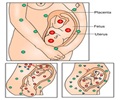
1. Sensational and stereotypical portrayal of childbirth in the media
2. Real life stories that they hear from friends and family members
3. Antenatal information offered by doctors, midwives and other educators
4. Their own experiences of delivering a child.
It is a common perception that the visual media influences the viewers and researchers have now come up with scientific evidence to prove the above-mentioned perception regarding pregnancy and childbirth-related areas. The faculty of Bournemouth University, UK has done a scoping review to seek the representation of childbirth on television to influence expecting mothers.
a) Misrepresentation of delivery - portraying it as a scary and risky event
b) Media being the major source for pregnant women to learn about childbirth, even though it has been depicted in a negative way.
c) Childbirth being missed as a regular day to day life event.
The above-mentioned themes were presented under key media sources such as television, print media, and books. The study has revealed that there was a difference in the way each country depicts childbirth. For instance, the North-American perspective is that medicalized process is the only option for expectant mothers and in the UK, such a perspective has just begun to emerge.
Medicalization:
Earlier to 1950s the midwives played an important role in labor. However, their roles started diminishing after the influence of obstetricians who started to categorize childbirth as normal and abnormal and that a set of skills (like surgeries) that formally trained healthcare specialists could only perform. Such medical intervention began to influence medicalization of birth to displace midwives as the primary maternity care provider. The medical professionals have convinced the expectant mothers that childbirth in hospitals is much safer and less painful.
Unnecessary Interventions & Negative Decisions:
A majority of the developed countries experience increased rates of interventions related to childbirth. Some of them are unnecessary and related to high maternal and newborn morbidity. A childbirth scene portrayed in a television program might showcase natural birth as a painful process and an expectant woman watching it might get scared of delivering the baby in a normal way and might opt for a C-section. In those cases, the mother who opts for a planned C-section might suffer a cardiac arrest and require a hysterectomy (surgical removal of the uterus) and the newborn baby gets admitted to the intensive care unit.
Media portrayal might narrow the options for expecting mothers to focus their attention on giving a safe birth. The media reminds first time mothers that labor is a potentially dangerous condition that leaves them with no choices than to seek doctors to save them as well as their children. They start viewing labor pain as a negative attribute and normal birth is no longer a natural experience that they own.
Missing Scenes of Normal Birth:
In most of the media presence, the nature of normal delivery remains missing. Television is a genre renowned to exaggerate the truth and the media needs dramatic and unusual events like crisis or dangers and unpredictable and fast deliveries to showcase doctors as heroes. Hence, a typical normal slow and lengthy delivery without pain relief and medical interventions and where midwives take charges are less likely to be portrayed. In that event, the media fails to understand the role it can play in the lives of people.
Many pregnant women find TV shows helpful as they help them understand what actually happens during childbirth. First-time mothers find it useful as they get to see maternity wards and they understand what to expect. It is important that medical educators and midwives engage with the producers of TV shows and other media to represent childbirth with more accuracy so as to not affect a woman’s view of labor.
References:
1. Ann Luce, Marilyn Cash, Vanora Hundley, Helen Cheyne, Edwin van Teijlingen, and Catherine Angell “Is it realistic?” the portrayal of pregnancy and childbirth in the media BMC Pregnancy Childbirth. 2016; 16: 40. Published online 2016 Feb 29. doi: 10.1186/s12884-016-0827-xPMCID: PMC47706722. Morris T1, McInerney K. Media representations of pregnancy and childbirth: an analysis of reality television programs in the United States.Birth. 2010 Jun;37(2):134-40. doi: 10.1111/j.1523-536X.2010.00393.x.
Source-Medindia














